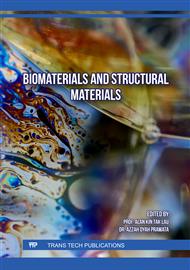[1]
I. Delidovich and R. Palkovits, Catalytic activity and stability of hydrophobic Mg-Al hydrotalcite in the continuous aqueous-phase isomerization of glucose into fructose, Catal. Sci. Technol. vol. 4, no. 12 (2014) 4322–4329
DOI: 10.1039/c4cy00776j
Google Scholar
[2]
A. R. Permanasari, A. Fauzan, N. L. Rachmalia, R. Elfanti, and W. Wibisono, Fructose syrup production from Onggok with isomerization process by Mg/Al hydrotalcite catalyst and glucose isomerase enzyme, J. Phys. Conf. Ser. vol. 1450, no. 1 (2020)
DOI: 10.1088/1742-6596/1450/1/012002
Google Scholar
[3]
F. Yulistiani, Saripudin, L. Maulani, W. S. Ramdhayani, W. Wibisono, and A. R. Permanasari, Fructose Syrup Production from Tapioca Solid Waste (Onggok) by Using Enzymatic Hydrolysis in Various pH and Isomerization Process, J. Phys. Conf. Ser. vol. 1295, no.1 (2019)
DOI: 10.1088/1742-6596/1295/1/012032
Google Scholar
[4]
C. Moreau, R. Durand, A. Roux, and D. Tichit, Isomerization of glucose into fructose in the presence of cation-exchanged zeolites and hydrotalcites, Appl. Catal. A Gen. vol. 193, no. 1–2, (2000) 257–264
DOI: 10.1016/s0926-860x(99)00435-4
Google Scholar
[5]
S. Yu, E. Kim, S. Park, I. K. Song, and J. C. Jung, Isomerization of glucose into fructose over Mg-Al hydrotalcite catalysts, Catal. Commun. vol. 29, (2012) 63–67
DOI: 10.1016/j.catcom.2012.09.015
Google Scholar
[6]
D. Steinbach, A. Klier, A. Kruse, J. Sauer, S. Wild, and M. Zanker, Isomerization of glucose to fructose in hydrolyzates from lignocellulosic biomass using hydrotalcite, Processes. vol. 7, (2020) 1–15.
DOI: 10.3390/pr8060644
Google Scholar
[7]
D. G. Cantrell, L. J. Gillie, A. F. Lee, and K. Wilson, Structure-reactivity correlations in MgAl hydrotalcite catalysts for biodiesel synthesis, Appl. Catal. A Gen., vol. 287, no. 2, (2000) 183-190
DOI: 10.1016/j.apcata.2005.03.027
Google Scholar
[8]
J. Lecomte, A. Finiels, and C. Moreau, Kinetic study of the isomerization of glucose into fructose in the presence of anion-modified hydrotalcites, Starch/Staerke, vol. 54, no. 2, (2002) 75–79
DOI: 10.1002/1521-379x(200202)54:2<75::aid-star75>3.0.co;2-f
Google Scholar
[9]
I. Delidovich and R. Palkovits, Structure-performance correlations of Mg-Al hydrotalcite catalysts for the isomerization of glucose into fructose, J. Catal. vol. 327 (2015) 1–9
DOI: 10.1016/j.jcat.2015.04.012
Google Scholar
[10]
L.P.F. Benício, R.A. Silva, J.A. Lopes, D.Eulálio, R.M.M. dos Santos, L.A. De Aquino, L. Vergütz, R.F. Novais, L.M. Da Costa, F.G. Pinto, J. Tronto, Layered double hydroxides: Nanomaterials for applications in agriculture | Hidróxidos duplos lamelares: Nanomateriais para aplicações na agricultura, Rev. Bras. Cienc. do Solo, vol. 39, no. 1 (2015)
DOI: 10.1590/01000683rbcs2015081
Google Scholar
[11]
B. H. Boehm, J. Steinle, and Z. X. Ci-, [Zn2Cr(OH)6]X.2Hz0, New Layer Compounds Cap able of Anion Exchange and Intracrystalline Swelling, Angew. Chem. lnt. Ed. Engl. 16 No. 4, (1977) 265–266
DOI: 10.1002/anie.197702651
Google Scholar
[12]
F. Zhang, N. Du, H. Li, X. Liang, Sorption of Cr(VI) on Mg–Al–Fe Layered 1 Double Hydroxides 2 Synthesized by Mechanochemical Method ( 2014)
DOI: 10.1039/c4ra07553f
Google Scholar
[13]
W. Y. Zhang, Y. Liu, and L. J. Xi, Adsorption of chloride anion by calcined Mg-Al-Fe layered double hydroxides in wastewater, Appl. Mech. Mater. vol. 423–426 (2013) 545–549
DOI: 10.4028/www.scientific.net/amm.423-426.545
Google Scholar
[14]
Y. Yang, N. Gao, W. Chu, Y. Zhang, and Y. Ma, Adsorption of perchlorate from aqueous solution by the calcination product of Mg/(Al-Fe) hydrotalcite-like compounds, J. Hazard. Mater. vol. 209–210 (2012) 318–325
DOI: 10.1016/j.jhazmat.2012.01.026
Google Scholar
[15]
L. Xiao, W. Ma, M. Han, and Z. Cheng, The influence of ferric iron in calcined nano-Mg/Al hydrotalcite on adsorption of Cr (VI) from aqueous solution, J. Hazard. Mater. vol. 186, no. 1, (2011) 690–698
DOI: 10.1016/j.jhazmat.2010.11.052
Google Scholar
[16]
S. K. Sharma, P. K. Kushwaha, V. K. Srivastava, S. D. Bhatt, and R. V. Jasra, Effect of hydrothermal conditions on structural and textural properties of synthetic hydrotalcites of varying Mg/Al ratio, Ind. Eng. Chem. Res., vol. 46, no. 14, (2007) 4856–4865
DOI: 10.1021/ie061438w
Google Scholar
[17]
Haruda, M. Satria, Fadli, A., Yenti, S.R, Pengaruh pH dan Waktu Reaksi pada Sintesis Hidroksi apatit dari Tulang Sapi dengan Metode Presipitasi, (The effect of pH and The Reaction Time on The Hydroxyapatite Synthesis from The Beef bones), FTEKNIK. 3 (1) (2016) 1-7 (in Bahasa).
DOI: 10.22487/j24775398.2017.v3.i3.9329
Google Scholar
[18]
I. Ridwan, C. Chinwanitcharoen, and K. Tamura, A new biodiesel production by water addition to supercritical tert-butyl methyl ether using a plug flow reactor, Fuel. vol. 305, no. 121512 (2021)
DOI: 10.1016/j.fuel.2021.121512
Google Scholar
[19]
Safitri, T., Sulistyaningsih, T., Kusumastuti, E., Preparasi Mg/Al/Fe-NO3 Hidrotalsit Secara Kopresipitasi, (Preparation of Mg/Al/Fe-NO3 Hydrotalcite with Coprecipitation), Indonesian Journal of Chemical Science. 8 (1) (2019) 41-46 (in Bahasa).
Google Scholar
[20]
C. A. Johnson and F. P. Glasser, Hydrotalcite-like minerals (M2Al(OH 6(CO3)0.5XH2O, where M = Mg, Zn, Co, Ni) in the environment: Synthesis, characterization and thermodynamic stability, Clays Clay Miner. vol. 51, no. 1 (2003) 1–8
DOI: 10.1346/ccmn.2003.510101
Google Scholar
[21]
S. Moriyama, K. Sasaki, and T. Hirajima, Effect of freeze drying on characteristics of Mg–Al layered double hydroxides and bimetallic oxide synthesis and implications for fluoride sorption, Appl. Clay Sci. vol. 132–133 (2016) 460–467
DOI: 10.1016/j.clay.2016.07.016
Google Scholar
[22]
D. G. Tong, W. Chu, Y. Y. Luo, X. Y. Ji, and Y. He, Effect of crystallinity on the catalytic performance of amorphous Co-B particles prepared from cobalt nitrate and potassium borohydride in the cinnamaldehyde hydrogenation, J. Mol. Catal. A Chem. vol. 265, no. 1–2, (2007) 195–204
DOI: 10.1016/j.molcata.2006.10.032
Google Scholar
[23]
R. Zhao, C. Yin, H. Zhao, and C. Liu, Synthesis, characterization, and application of hydotalcites in hydrodesulfurization of FCC gasoline, Fuel Process. Technol. vol. 81, no. 3 (2003) 201–209
DOI: 10.1016/s0378-3820(03)00012-2
Google Scholar



